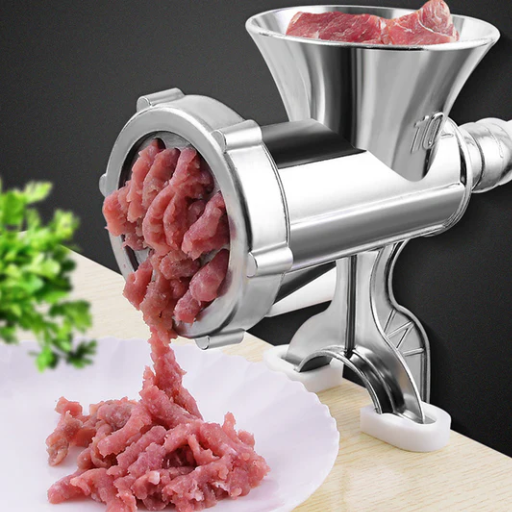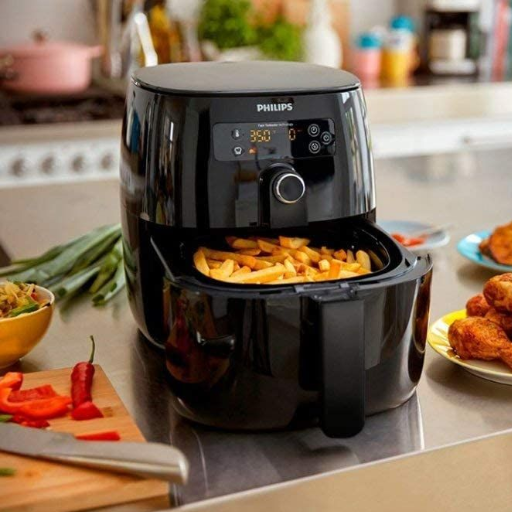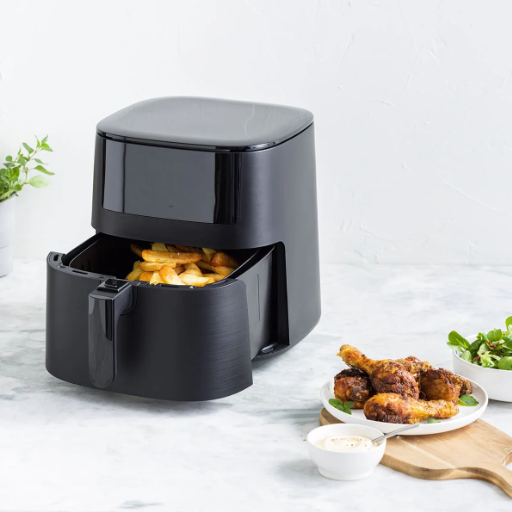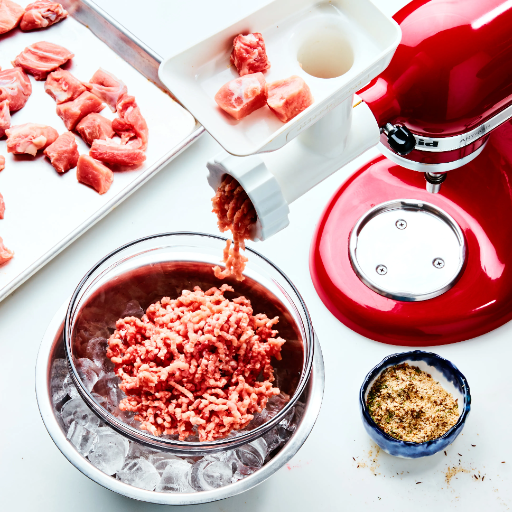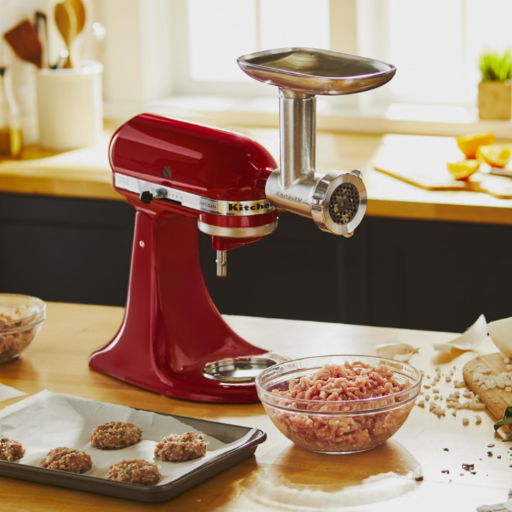Through all the steps for the preparation of an ideal homemade sausage, having the proper equipment is critical. That meat grinder is a nec plus ultra for anybody who wants to govern the flavor, texture, and quality of their sausages. For the house cook experimenting with flavors or a butcher looking for dependability and precision, the key is to find the best meat grinder for stuffing sausage. This guide will offer in-depth reviews of some of the best grinders on the market, point out some standout features, and help you select the right model for you. We will discuss everything from design features and ease of use to price so unsuspecting sausage makers can go forth and make great sausages.
What Are the Best Meat Grinders on the Market?
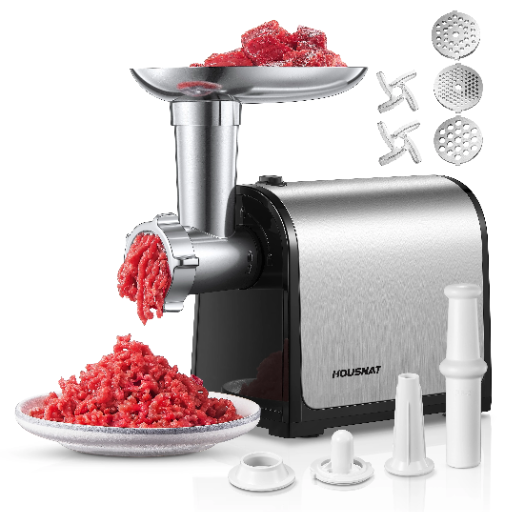
- STX Turboforce Classic 3000 Series
With a highly effective motor of 3000W and tremendous versatility, this grinder is very high on the list among popular grinders. Multiple grinding plates come along with it, including stuffing tubes and a sausage stuffing kit. Hence it is suitable for both home and commercial uses. The Grinder also has the patented “Quad Air Cooling” system that adds to the durability of the motor.
- KitchenAid Metal Food Grinder Attachment
This attachment is designed for the KitchenAid stand mixers and is, therefore, a convenient and reliable option for the home cook with fine, medium and coarse grinding plates and sausage stuffing tubes. Being all-metal, it will last for a long time.
- LEM Products Big Bite Electric Meat Grinder
Dating back to over two decades, ‘Big Bite’ owns the reputation of durability and excellent processing. It has features such as a forever lubricated motor and a more oversized meat tray for quicker processing. To put it simply, it is a wonder, especially if you do big processing jobs regularly.
- Sunmile SM-G50 Electric Meat Grinder
This compact yet efficient grinder offers excellent value for money in the home environment. Being equipped with a 1000W motor and stainless steel grinding plates and boasting easy operating processes, this grinder is best suited for those beginning or casual sausage producers.
- Weston Pro Series Electric Meat Grinder
Weston Pro Series is one of the professional machines with an efficient motor and fully stainless body. With its speed and capacity, it is well suited to large meat processing on a regular basis.
All of these grinders have found acclaim for their performance, ease of working, and build life. However, the one that is right for you will depend on what your specific needs are, whether you work with heavy meat supplies or are just confined by budget.
Best Budget Meat Grinder Options
- ALTRA Electric Meat Grinder
This grinder features a powerful motor rated at 350W, which, under ideal conditions, can grind up to 2 pounds of meat in 1 minute. It has sharp stainless steel blades to handle most processing. Additional accessories are included to provide more versatility in use, such as sausage-making attachments. The exterior design is sleek and remarkably lightweight, so few would consider storing and cleaning to be a hindrance; it is certainly the one to get when on a budget.
- Sunmile SM-G31 Electric Meat Grinder
A true value grinder. Sunmile SM-G31 is a good, entry-level grinder with a simple design and a 250W motor. It handles small to medium grinding tasks well, although it is a little loud. The grinder is made with a die-cast aluminum tray and metal gearbox to allow for long life. It comes with three stainless steel cutting plates that allow for a fine, medium, and coarse grind.
- Homeasy Electric Meat Grinder & Food Processor
This multi-purpose grinder combines meat grinding with food processing capabilities, offering great value for the price. Thanks to an 8-cup capacity and 350-Watt power, it rapidly chops meat, vegetables, and other ingredients. It is also designed with dishwasher-safe parts for easy cleanup. Its small size is a dream for smaller kitchens.
Best Splurge: High-End Meat Grinders
High-end meat grinders embody the peak of engineering and design in this field, offering the most performance with advanced features. Mostly with commercial-grade motor power, sturdy stainless steel components, and added functionalities for better efficiency and precision, these units are a holy grail for dispositions.
The LEM Big Bite Electric Meat Grinder can be regarded as one of the worthy mentions. This 1.5 HP heavy-duty motor can grind up to 17 pounds of meat per minute, perfect for industrial-level needs or backyard culinary gurus. Its precision-made auger diminishes user inputs in pushing the meat, thereby requiring the worker to engage less in the process, making the whole thing safer. Furthermore, its stainless steel housing affords it durability for years to come, and it is easy to clean.
The STX TurboForce II “Platinum” Grinder is another high-level grinder, with extra horsepower and advanced cooling to keep it from overheating. This grinder makes the whole operation versatile, offering grinding plates and other attachments for various texture and preparation. Moreover, the design of the STX TurboForce II “Platinum” Grinder appeals to noise reduction, ensuring an almost quiet operation with power intact.
How to Choose the Right Meat Grinder?
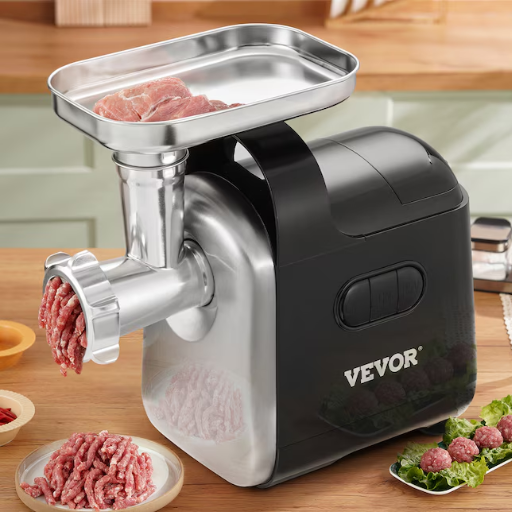
- Capacity and Power – Estimate the amount of meat you plan to grind and the frequency of the process. If working for a greater amount of time and grinding larger capacities, it is worth going for an electric grinder with at least 500 watts of power. A manual grinder or an electric one with less power might be suitable for sporadic use.
- Durability – A grinder construction from high-quality materials such as stainless steel or very strong plastic is the best where possible. They last longer and are simpler to wash.
- Attachments and Versatility – Opt for a grinder equipped with various plates and attachments so that it may be used for sausage-making and other purposes.
- Ease of Cleaning – Go for a grinder with parts that are removable and dishwasher-safe or easy to clean by hand. Keeping things clean is essential when working with raw meat.
- Noise Level – If you are concerned with noise, then consider such a grind that is manufactured solely for noise reduction.
By concentrating on these aspects, you will readily find a grinder that efficiently serves your particular purpose.
Understanding Grinder Attachments and Their Uses
- Grinding Plates: They usually come with plates having holes of varying sizes. Coarse plates are ideal for making ground chuck or sausage mixtures, while the fine ones go well with smooth pastes or finely minced meats required by recipes of a delicate texture.
- Sausage Stuffers: These attachments are designed for filling sausage casings right from the grinder. They come in different tube sizes so that they can hold various types of sausages-thin for breakfast links or large for bratwursts. Properly aligned and lubricated, they work best.
- Kubbe Attachments: Made just for kubbe, a Middle Eastern traditional gotta, these attachments let a user prepare hollow casings of dough or meat to be filled. This attachment aids in cuisines that require delicate preparation work.
- Pasta Makers: Some grinders have a number of features, including various pasta maker attachments that impart shaping capacities for fresh pasta against the release of pasta in shapes such as spaghetti or fettuccine. Pasta-making attachments save time for cooks who want homemade pasta.
- Vegetable Slicers/Shredders: Measurement of vegetables is another useful attachment that helps expand the use of this appliance to salads and side dishes. It always goes with adjustable blades for customizable precision.
Coarse vs. Fine Grinding Plates: What’s the Difference?
|
Aspect |
Coarse Grinding Plates |
Fine Grinding Plates |
|---|---|---|
|
Texture of Output |
Creates larger, chunkier pieces |
Produces smooth, fine consistency |
|
Ideal Uses |
Burgers, sausages, meatloaf |
Pâtés, spreads, baby food |
|
Hole Size (Approx.) |
6-8 mm |
2-4 mm |
|
Processing Time |
Faster grinding due to larger holes |
Longer due to finer granularity |
|
Meat Type Suitability |
Tougher or less tender cuts |
Softer, delicate meats |
|
Other Applications |
Coarse vegetable chopping |
Fine breadcrumbs, nut butters |
|
Preferred Recipes |
Hearty dishes requiring texture |
Smooth dishes or fine emulsions |
Key Features to Look for in a Meat Grinder
- Motor Power and Wattage
The motor’s power directly affects the grinder’s speed and efficiency. Household meat grinders usually boast an operation power in the 300-800-watt range; commercial ones can come with an amount over 1,000 watts to be wielded in the toughest operations. A 1,000-watt motor allows for steady work, given the larger batches of meat or harder cuts of meat.
- Material Construction
Materials that rate superior to others are those being considered as stainless steel or cast iron because such materials provide the grinder with durability against wear and tear, corrosion resistance, and a clean finish. Plastic materials offer the advantages of being lightweight, but with least strength and a tendency to wear out with time. Look for grinders with all-metal gears for longer service life.
- Grinding Capacity
A grinder’s capacity, typically stated in pounds per minute (lbs/min), varies widely. Residential grinders normally grind 1 to 2 lbs a minute, while the larger units grind 8 to 12 lbs per minute or more, basically putting them in a commercial category.
- Reverse Function
The reverse operation prevents clogging as food is pushed backwards through the grinder, ensuring greater efficiency of processing when dealing with fibrous materials. This feature especially pays dividends when time and volume are critical issues in dense processing.
- Attachments and Accessories
Good-quality grinders generally have an array of accessories: sausage-stuffing tubes, kibbeh attachments, and grinding plates. These make appliances that are slightly more specialized in their functioning to accommodate specialized recipes.
Taking all these factors into account will help you decide upon a meat grinder that fits your requirements and provides efficient, durable, and fine-processing results in food preparation.
Can a KitchenAid Stand Mixer Be Used as a Meat Grinder?
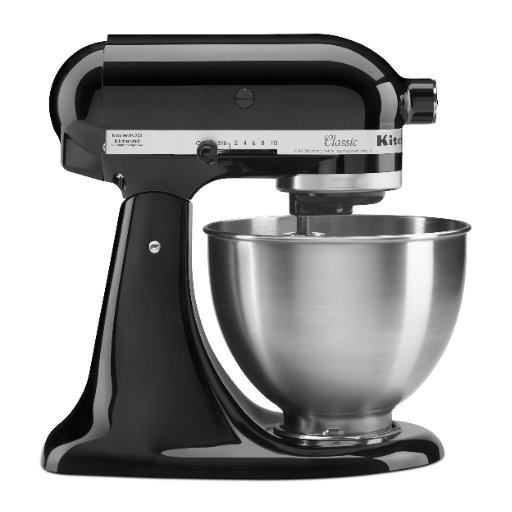
Yes! A KitchenAid stand mixer can be used as a meat grinder, provided that the meat grinder attachment is connected to it. KitchenAid has, in fact, put on the market a meat grinder attachment that attaches conveniently into the special power hub of its stand mixer, allowing you to grind meat with ease. The attachment normally has two or three grinding plates for different levels of coarsenes,s so you can select various texture levels; however, for heavy-duty tasks, it will never really compete with a true meat grinder, but it makes for a marvelous choice when dealing with smaller quantities or application from time to time.
Using the Metal Food Grinder Attachment
Safe implementation of the metal food grinder attachment begins with ensuring the stand mixer is unplugged to prevent accidental operation. Attach the grinder body to the Power Hub by aligning it with the fitting and tightening the thumb screw as securely as you can. Insert the auger into the grinder body, then insert the blade, and attach your chosen grinding plate-coarse or fine, depending on desired texture. Lock these components into place with the front ring nut.
Best Practices for Grinding Meat with KitchenAid
Keeping the meat and grinder attachment cold throughout the process ensures an even and quality grind. Warm meat will tend to smear, giving a bad texture and poor flavor retention. Before beginning, place the grinder attachment and meat in the freezer for 15 to 30 minutes. The intent is to keep the metal cold so it won’t heat up much whilst grinding and thus won’t be able to wax the meat by force. Also, cut the meat evenly into approximately 1-inch cubes to feed nicely into the hopper without clogging or putting strain on the motor.
The commonly used coarse grinding plate produces chunkier meat for sausages, chili, and burger patties. A finer plate appropriate for meatloaf or pate will result in a very smooth texture. Always ensure that the plate is firmly secured so that the operation will not be disrupted. When grinding in two passes, go coarse first to break down the meat well and fine afterward for the final texture.
What is the Best Way to Make Sausage?
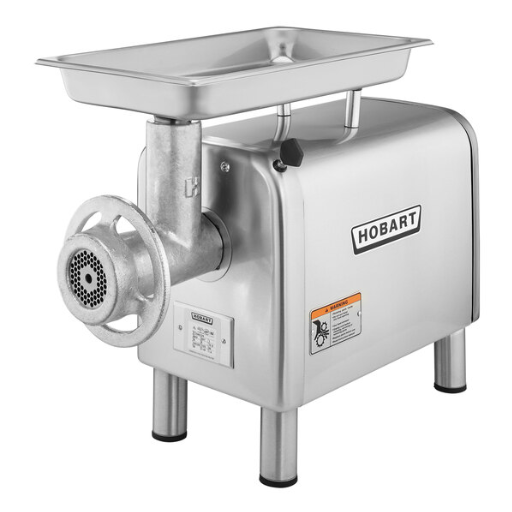
The procedure of making sausage commences with selecting good quality meat such as pork shoulder, which maintains the ideal balance of fat and lean meat. Chill the meat and equipment to maintain food safety and secure clean cuts during grinding. Use the coarse grinding plate to do the first grinding so the ground meat can be evenly mixed with your seasonings to create an even distribution of the flavor. Should you prefer a smoother texture, regrind the meat with the finer plate after mixing.
After preparing the meat, load it into the sausage stuffer and fill pre-soaked casings gently with fairly even pressure to avoid air pockets. Twisting will be done next, with the length as preferred, after which ends are securely tied up. Refrigerate for a few hours or preferably overnight for flavor melding before cooking or packing.
Choosing the Right Sausage Stuffer and Tubes
Choosing the sausage stuffer for your needs will result in consistent results and greatly enhance the overall efficiency of the sausage-making process. Several styles exist to include vertical, horizontal, and horn stuffers, which are useful for a practical scale or production views. These vertical stuffers have gained quite a bit of popularity due to their compact nature and ease of operation, making them suitable for the home user or small-scale operation. Horizontal stuffers are the main operational stuffers designed for higher capacity operations; these stuffers are mounted on a countertop for stability.
Tips for Stuffing Sausage Like a Pro
- Choose the Right Casing Type and Size
Choosing the right casing is essential to get the texture and preference. The natural casing is superior to texture and elasticity but must be well rinsed and soaked before use. Collagen casings are more uniform, easier to handle, but may offer a different bite when compared to natural. Use a casing sized for the type of sausage you are making-bedroom diameters vary from 19mm for snack sticks to 38mm or more for sausages such as bratwurst.
- Maintain Cold Temperatures
Keep your mixture of meat and equipment chilled throughout the stuffing to prevent smearing of the sausage mixture. Temperatures must be kept below 40°F (4°C) to maintain firm consistency and prevent the growth of bacteria. Refrigerate your meat grinder, stuffer, and stuffing tubes before you get started for even further reduction of friction and heat.
- Properly Season and Mix Your Meat
Season the meat evenly before beginning the stuffing procedure. Accurate seasoning quantities are imperative; 1.5 to 2% salt by weight of the meat is advised. Mix thoroughly, not just to diffuse the spices evenly, but to start protein binding as well it gives a texture that is firm but juicy to the sausage.
- Avoid Overstuffing the Casings
Casing will burst during cooking or drying if overfilled. Leave a tiny bit of slack time in the casing for its expansion. The rule-of-thumb is to keep the casing tight but flexible. Press the casing with consistent pressure throughout the entire stuffing process, and guide the meat into the casing using your fingers.
How Do Electric Meat Grinders Compare to Manual Meat Grinders?
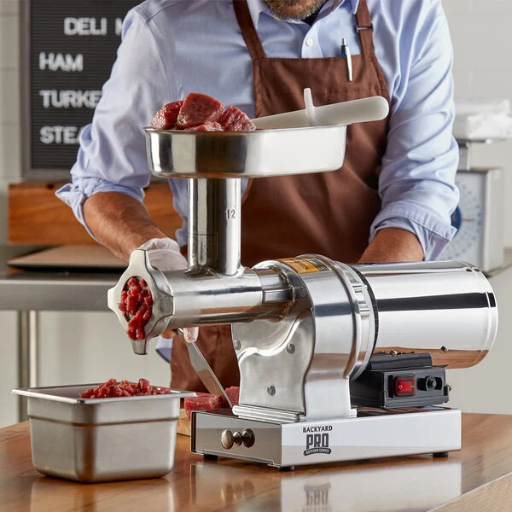
Electric meat grinders are usually more efficient and faster in grinding larger quantities of meat with minimum effort compared to manual meat grinders. An electric motor powers it to relieve manual labor and prevent fatigue for the user. In addition, most electric meat grinders feature several speed settings and many attachments, adding to their versatility when grinding meat or other ingredients.
The hand-cranked mechanism of manual meat grinders works slow and requires energy and endurance. They are cheaper, lighter, and portable and therefore good for casual grinding or smaller amounts. Manual grinders also do not need electricity and so can come in handy in areas that do not have power or for outdoor use.
Benefits of Electric Meat Grinders
- Efficiency and Speed
Designed to process meat quickly and efficiently, electric meat grinders, depending on motor power, can deal with 3-5 lbs. of meat per minute in the best circumstances, thus giving bulk processing the benefit of the time one would need in manual grinding.
- Consistent Grinding Results
Electrical grinders are equipped with very sharp blades and fast motors to impart the consistency of grind to the meat. This consistency is very important for recipes that require a specific texture of meat, such as making sausages or meatballs.
- Ease of Use
Electric grinders are easy to use, requiring less physical effort than manual types. Most types just have an on/off button or panel and thus this class of grinders is easy enough for beginners.
- Versatility in Functionality
With fine, medium, and coarse plates for exchangeability, many of these grinders also have additional attachments for other tasks besides meat grinding, such as pasta production, sausage stuffing, or even vegetable grinding.
- Time-Saving for Large Batches
Electric grinders save time during preparation for high production volumes. Models with high horsepower (500 watts and above) can easily handle tougher meats and bigger amounts.
Electric meat grinders offer the home cook and the professional alike quality, speed, precision, and enhancement to the process of meat preparation. The ability to perform tasks efficiently puts them above manual grinders, especially where heavy and frequent use is concerned.
When to Use a Manual Meat Grinder?
A manual meat grinder is best suited for users who test smaller consignments of meat and consider simplicity, portability, and cost-effectiveness in their tools. Such appliances run without electricity, hence making them handy during power outages or for anyone who treasures maintenance-free implements. Additionally, manual grinders grant users superior authority over grinding speed, which is beneficial when aiming for particular textures or avoiding heating up delicate cuts of meat.
Reference Sources
-
Meat Grinder–related Hand Injuries: A 50-year Systematic Review – This study assesses the prevalence and characteristics of hand injuries caused by meat grinders and identifies common treatments.
-
A Review on the Relation Between Grinding Process and Meat Quality – This review provides an overview of research on the forces acting in meat grinders and their impact on meat quality.
-
Engineering Parameters Affecting the Performance of Meat Grinders – This research discusses the design and operational parameters that influence meat grinder performance.
Frequently Asked Questions (FAQs)
Q: What are the top picks for the best meat grinders for sausage stuffing?
A: Some of the top picks include the Cuisinart electric meat grinder, the STX International Turboforce, the Weston meat grinder, and the KitchenAid metal food grinder attachment. These grinders have been tested for their performance in grinding beef and pork, and they deliver the best results for sausage stuffing.
Q: How does the Cuisinart electric meat grinder perform compared to other models?
A: The Cuisinart electric meat grinder is known for its durability and efficiency. It features a powerful motor that can handle grinding meat for burgers and sausage stuffing. With its high-quality grinder head and various grinder plates, it offers versatility for processing different types of meat.
Q: What should I look for in a meat grinder for home use?
A: When selecting a meat grinder for home use, consider factors such as motor power (measured in hp), ease of cleaning, the size of the grinder head, and the availability of different grinder plates. A model with at least 1 hp is recommended for grinding tougher cuts like pork butt, ensuring the grinder can process the meat effectively.
Q: Can the STX International Turboforce handle large quantities of meat?
A: Yes, the STX International Turboforce is designed for heavy-duty use and can handle processing large quantities of meat. It is capable of grinding several pounds of pork and beef quickly, making it a popular choice for those who frequently prepare freshly ground meat.
Q: What makes the Weston meat grinder a great choice for sausage making?
A: The Weston meat grinder is favored for its robust construction and efficient performance. It can grind meat quickly and comes with specialized attachments for stuffing sausage, making it ideal for anyone looking to create breakfast sausage or other homemade sausage varieties.
Q: How does the KitchenAid metal food grinder attachment compare to standalone grinders?
A: The KitchenAid metal food grinder attachment is a convenient option for those who already own a KitchenAid mixer. While it may not have the same power as standalone grinders, it is effective for small batches of meat and offers the advantage of easy storage and versatility for other food processing tasks.
Q: What are the benefits of using a 3000 series electric meat grinder?
A: A 3000 series electric meat grinder typically offers a powerful motor and enhanced grinding capabilities. It is designed to efficiently grind various types of meat, making it suitable for both casual home cooks and serious meat enthusiasts looking to process large chunks of meat.
Q: Can I grind different types of meat in the same grinder?
A: Yes, you can grind different types of meat, such as beef and pork, in the same grinder. However, it’s important to clean the grinder thoroughly between uses to prevent cross-contamination and to ensure the best flavor for each type of meat.
Q: What accessories should I consider for my meat grinder?
A: When choosing accessories for your meat grinder, consider purchasing additional grinder plates for various grind sizes, a meat stomper for safe feeding, and sausage stuffing tubes if you plan to make sausage. These accessories will enhance the versatility and functionality of your grinder.

